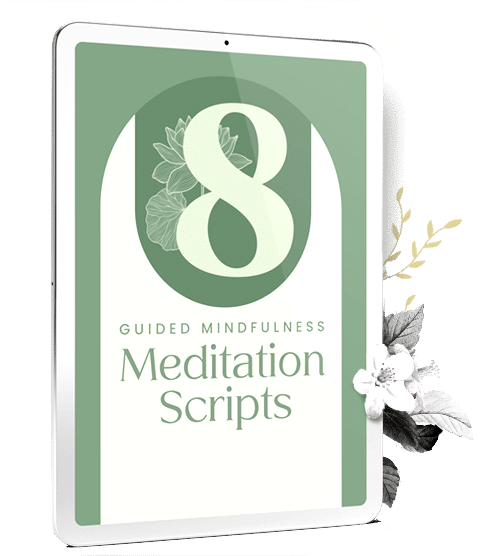Transcendental Meditation ® is a specific meditation technique that involves the repetition of a mantra, given to you personally by your TM instructor. The meditation style was introduced to the United States in the mid-20th century and quickly became well-known as a result of its celebrity following. Practicing twice daily can lead to a state of deep inner calm in which the mind is relaxed, clear and aware.
Learn more about what transcendental meditation is, how it differs from mindfulness, and what the two popular meditation techniques have in common.

What is Transcendental Meditation?
Transcendental Meditation ® is a meditation style with roots in ancient Vedic practices, but is decidedly modern technology. The technique was perfected in the 1950s by Maharishi Mahesh Yogi who based the practice on the teachings of his own guru, Brahmananda Saraswati (Guru Dev). A celebrity following that included The Beatles helped the meditation style gain popularity in the 1960s. Today, more than 6 million people worldwide have learned the user-friendly technique.
Part of the growth of TM may be due to the emphasis that it is a non-religious practice that requires no belief on the practitioner's part, nor any need to change one’s lifestyle or adopt a particular worldview. Even the greatest skeptics can use TM to transcend ordinary thought and experience a higher level of consciousness.
This deep level of awareness is brought about through the relaxed and steady silent repetition of a mantra. Mantra is a Sanskrit word that refers to a sacred syllable or sound. In TM, 1-2 syllable mantras are not meant to have meaning, but rather, a particular vibration. Repeating the mantra quiets the body and mind, allowing for an experience of pure consciousness.
Those who practice TM receive their mantra from a teacher. According to the official non-profit organization which oversees TM in the United States, it is not possible to learn authentic Transcendental Meditation from a YouTube video or book. Learning TM begins with a one-on-one teaching session followed by four group sessions. These sessions are offered on a sliding price scale that is based on one’s family income.
Practitioners of transcendental Meditation meditate twice daily for 20 minutes per session. The first session takes place in the morning and the second in the early evening. The preferred meditation posture is seated comfortably yet upright, with eyes closed.
The benefits of TM may include a deep sense of relaxation and improved energy, clarity and creativity. Like other forms of meditation, research shows TM benefits the body too, thus improving physical, mental and emotional well-being.

Different Benefits of Transcendental Meditation
Among the primary benefits of Transcendental Meditation are the simplicity and ease of the practice, combined with the 40-minute daily commitment and the guided introduction. Meditation works best for those who do it. By creating an accessible means of meditating consistently, Maharishi found a way to successfully initiate even the most distractible of skeptics into a fruitful practice.
Additional, commonly reported Transcendental Meditation benefits include the following:
Whether or not these benefits are evidence-based is debated despite a robust body of research on the benefits of TM. Many of these studies have been criticized as biased, for early TM researchers were frequently practitioners. That said, researchers continue to find that many of the above outcomes are indeed attributable to TM, just as they are for other forms of meditation practice.

The Science Behind Transcendental Meditation
Recent studies have found Transcendental Meditation evokes changes in the body and brain that may improve physical and mental health.
TM minimizes reactivity to stress
Our bodies react to stress by releasing hormones that trigger inflammation. This inflammation is unhealthy for both body and brain, increasing the risk of cardiovascular disease, diabetes and neurodegenerative diseases such as Alzheimer’s.
Regular practice of Transcendental Meditation moderates sympathetic nervous system activity, making the body and brain less reactive to stress. This has a potentially significant effect on reducing risk of disease and improving physical and mental wellness.
TM reduces risk factors for morbidity
Stress is among the primary risk factors for morbidity. Others include alcohol, nicotine and illicit drug use, psychophysiological disorders, endocrine imbalances and high blood pressure. Studies have found that Transcendental Meditation may help minimize these risk factors by helping people relax. What’s more, TM may do so more effectively than other forms of relaxation.
TM may make you smarter
A relaxed, calm mind is available for the experience of clarity and creativity. Results of longitudinal studies show a relationship between consistent participation in TM and improvements in measures of general intelligence. When compared to non-meditators, both high school students and seniors participating in TM showed improved cognition across a variety of measures.
Bringing Mindfulness to TM
Transcendental Meditation and mindfulness meditation are two distinctly different practices. Despite this, they have overlapping benefits, many of which are the result of the similar physiological changes in the body and brain. Secular meditation practices seem to primarily improve wellness by reducing stress and inflammation. Whether TM or mindfulness is more relaxing for you is quite personal.
Proponents of TM emphasize that the practice requires no strenuous effort, concentration or active contemplation. This is perhaps a bit of an oversimplification. With or without realizing it, anyone participating in a mantra practice is employing mindfulness, regardless of how effortless it seems. How else is one to know whether or not the mind is repeating the mantra?
That mindfulness requires strenuous concentrative effort, actively thinking about what’s happening, or engagement with the busy-ness of noticing everything is a misconception about what mindfulness is. Mindfulness is simply relaxed, accepting presence with this moment, just as it is.
Perhaps those who practice TM can enhance the benefits of their formal practice by bringing mindfulness to what they sense and how they process it between their meditation sessions. On the other hand, many mindfulness practitioners could benefit from inviting less doing and more being into their daily sessions.
Conclusion
Transcendental Meditation ® is an accessible, evidence-based practice that leads to profound inner calm and clarity. While its benefits may not be exclusive to TM, there’s no doubt that there are benefits to the mantra-based, twice-daily practice. As with any style of meditation, whether or not it helps you feel more joyful, at peace and at ease is something only you can decide, and only after you have tried it.
REFERENCES
- 1Jose Rafael Infante, Miguel Torres-Avisbal, Pilar Pinel, Juan Antonio Vallejo, Fernando Peran, Francisco Gonzalez, Pablo Contreras, Carmen Pacheco, Jose Marı́a Latre, Ana Roldan, Catecholamine levels in practitioners of the transcendental meditation technique, Physiology & Behavior, Volume 72, Issues 1–2, 2001,Pages 141-146, ISSN 0031-9384
- 2Fred Travis, David A.F. Haaga, John Hagelin, Melissa Tanner, Sanford Nidich, Carolyn Gaylord-King, Sarina Grosswald, Maxwell Rainforth, Robert H. Schneider, Effects of Transcendental Meditation practice on brain functioning and stress reactivity in college students, International Journal of Psychophysiology, Volume 71, Issue 2, 2009, Pages 170-176, ISSN 0167-8760
- 3Balaji PA, Varne SR, Ali SS. Physiological effects of yogic practices and transcendental meditation in health and disease. N Am J Med Sci. 2012;4(10):442-448. doi:10.4103/1947-2714.101980
- 4James W. Anderson, Chunxu Liu, Richard J. Kryscio, Blood Pressure Response to Transcendental Meditation: A Meta-analysis, American Journal of Hypertension, Volume 21, Issue 3, March 2008, Pages 310–316
- 5Alexander, C. N., Robinson, P., Orme-Johnson, D. W., Schneider, R. H., et al. (1994). The effects of transcendental meditation compared to other methods of relaxation and meditation in reducing risk factors, morbidity, and mortality. Homeostasis in Health and Disease, 35(4-5), 243–263.
- 6Robert W. Cranson, David W. Orme-Johnson, Jayne Gackenbach, Michael C. Dillbeck, Christopher H. Jones, Charles N. Alexander, Transcendental meditation and improved performance on intelligence-related measures: A longitudinal study, Personality and Individual Differences, Volume 12, Issue 10, 1991, Pages 1105-1116, ISSN 0191-8869
- 7Nidich, Sanford & Schneider, Robert & Nidich, R.J. & Foster, G. & Sharma, H. & Salerno, John. (2005). Effect of the transcendental meditation program on intellectual development in community-dwelling older adults. J Soc Behav Pers.. 17. 217-226
- 8Kam-Tim So, David W Orme-Johnson, Three randomized experiments on the longitudinal effects of the Transcendental Meditation technique on cognition, Intelligence, Volume 29, Issue 5, 2001, Pages 419-440, ISSN 0160-2896














